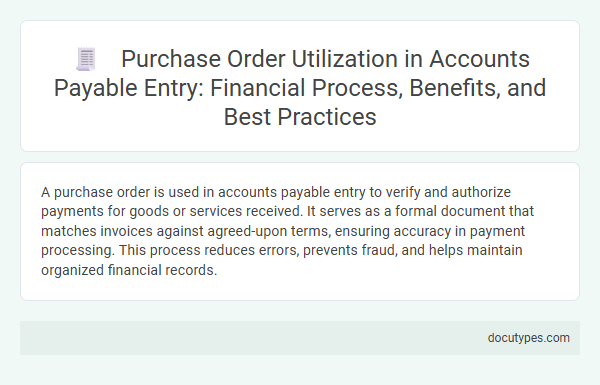A purchase order is used in accounts payable entry to verify and authorize payments for goods or services received. It serves as a formal document that matches invoices against agreed-upon terms, ensuring accuracy in payment processing. This process reduces errors, prevents fraud, and helps maintain organized financial records.
Introduction to Purchase Order Utilization in Finance
Purchase orders (POs) are essential documents in accounts payable, serving as formal requests for goods or services that provide vendors with clear transaction details. Utilizing purchase orders streamlines invoice verification and enhances financial accuracy within organizations.
- Purchase order initiation - POs are generated to officially authorize purchases, detailing quantities, prices, and delivery terms for accountability.
- Invoice matching - Accounts payable uses POs to compare invoices against ordered items, ensuring accuracy before payment processing.
- Financial control - The use of POs minimizes errors and fraud, supporting budgeting and audit trails in financial management.
The Role of Purchase Orders in Accounts Payable
A purchase order serves as a critical document in accounts payable by authorizing and documenting the purchase of goods or services. It ensures accuracy and accountability during the invoice verification and payment process.
- Verification - Purchase orders allow your accounts payable team to verify that the invoice matches the agreed terms before payment is processed.
- Approval - They provide formal approval for expenses, reducing the risk of unauthorized payments.
- Record Keeping - Purchase orders maintain a clear audit trail, supporting financial reporting and compliance efforts.
Using purchase orders within accounts payable streamlines payment workflows and strengthens financial control.
Key Steps in the Purchase Order Entry Process
A purchase order (PO) is a crucial document in the accounts payable process, serving as a formal request to suppliers for goods or services. It establishes clear terms such as quantity, price, and delivery date, ensuring accurate financial records.
The entry process begins with verifying the purchase order details against invoices and receiving reports. Accurate PO entry helps prevent payment errors, supports budget tracking, and maintains compliance with company policies.
Streamlining Accounts Payable with Purchase Orders
| Aspect | Description |
|---|---|
| Definition of Purchase Order (PO) | A Purchase Order is a formal document issued by the buyer to the supplier, detailing the products or services requested, quantities, and agreed prices. |
| Role in Accounts Payable (AP) | POs serve as a verification tool in the AP process, ensuring invoices match authorized purchase details before payment processing. |
| Streamlining Invoice Verification | Matching invoices against POs reduces errors and discrepancies, preventing overpayments or fraudulent invoices within the AP workflow. |
| Efficient Payment Authorization | With a PO reference, AP teams can quickly validate approvals and release payments, accelerating the payment cycle and improving vendor relationships. |
| Improvement in Financial Controls | Purchase Orders enforce spending limits and budget compliance, providing clear audit trails that enhance internal controls in the AP process. |
| Integration with ERP Systems | Automated PO matching within Enterprise Resource Planning (ERP) systems minimizes manual entry, cut processing time, and reduces human errors in accounts payable. |
| Impact on Cash Flow Management | PO-driven accounts payable entries enable better cash flow forecasting by aligning actual liabilities with approved purchase commitments. |
| Summary | Using purchase orders in accounts payable creates a streamlined workflow with enhanced accuracy, control, faster payment cycles, and improved financial visibility. |
Financial Controls Enhanced by Purchase Order Utilization
How does a purchase order improve financial controls in accounts payable entry? A purchase order creates a formal record that verifies the details of a transaction before payment is processed. This ensures accuracy and prevents unauthorized or duplicate payments, enhancing your organization's financial integrity.
Benefits of Integrating Purchase Orders in AP Workflows
Purchase orders streamline the accounts payable (AP) process by providing clear documentation for each transaction. They help ensure accuracy in coding expenses and matching invoices with authorized purchases.
Integrating purchase orders in your AP workflow reduces errors and prevents duplicate payments. This integration enhances financial control, improves audit readiness, and speeds up invoice processing times.
Common Challenges in Purchase Order Processing
Purchase orders play a critical role in accounts payable by serving as official documentation authorizing a purchase transaction. They help verify that goods or services received match the agreed terms before payment is processed.
Common challenges in purchase order processing include mismatched invoices, delays in approvals, and inaccuracies in data entry. Mismatched invoices often occur when purchase order details do not align with vendor billing, causing payment delays. Manual data entry increases the risk of errors, complicating reconciliation between purchase orders and accounts payable records.
Best Practices for Purchase Order Management in Finance
A purchase order (PO) serves as a critical document in accounts payable entry by verifying and authorizing expenses before payment processing. Best practices for purchase order management in finance include maintaining clear documentation, matching POs with invoices and receipts, and enforcing approval workflows to prevent errors and fraud. Effective PO management streamlines accounts payable operations, enhances financial control, and supports accurate budgeting and auditing.
Leveraging Technology in Purchase Order and AP Integration
A purchase order (PO) serves as a critical document in accounts payable (AP) by providing clear authorization and details of the transaction, enabling accurate invoice matching and payment processing. Leveraging technology through integrated AP and purchase order systems automates data entry, reduces errors, and accelerates payment cycles. Real-time synchronization between procurement and finance ensures compliance, improves cash flow management, and enhances audit trail transparency.
How Is a Purchase Order Used in Accounts Payable Entry? Infographic

